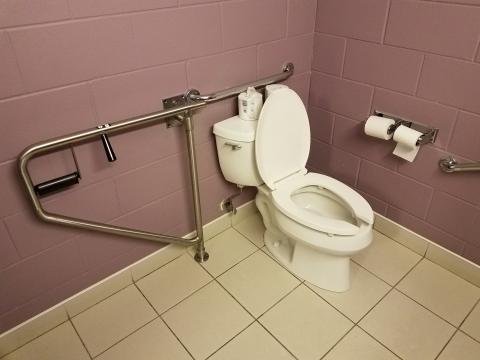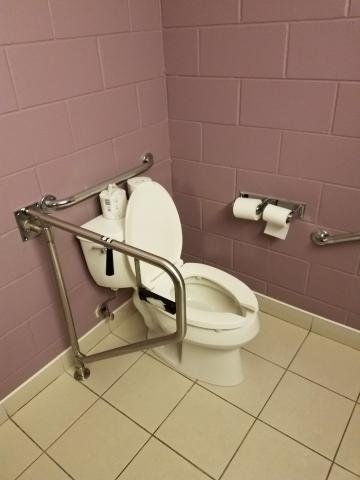Five Ideas for Creating Belonging
2 comments
818 views

Before Christ, only the high priest, only one day each year, was allowed to enter God’s throne room, but when Jesus died, the curtain separating us from God’s throne room, the most holy place, was torn in two and all barriers fell away. The gracious host of that amazing space welcomes all believers, no structural, communication, or attitudinal barriers there, no matter the challenge we face. We who have been welcomed into the throne room of God like to believe that our churches give as wide a welcome to all people.
As in all other things, we need sanctification. To sanctify our spaces, our communications, and our attitudes, new ideas can help. Here are five ideas for belonging and an example for each.
See people for what they can do.
Destination Christian Reformed Church, St. Thomas ON – A fundamental principle of asset based community development is to look first for assets and strengths in a community, not needs. Wise churches practice the same principle with each individual they meet. When Devon first started attending Destination, pastor Beth invited him to pour coffee. Devon faces some challenges in life, but he has increased his involvement at Destination. Destination hosts drop in hours almost every day, and Devon’s there nearly every day making and serving coffee and welcoming everyone who stops by.
Intentionally make connections.
Plymouth Heights CRC, Grand Rapids MI – When some of the people with intellectual disabilities from Plymouth’s Friendship Group first attended Sunday morning worship, they sat together in one pew. They were included but did not belong. Not content with this together-but-separate approach, the Friendship Group leader at the time approached families and individuals in the congregation to ask them if they would welcome someone from the Friendship group to sit with them. Connections were made. People began looking for each other before the start of worship. Friendships blossomed. Because they look for each other each Sunday morning, if any of them is not present, he or she is missed, which is a mark of belonging. Cara Milne, a Regional Disability Advocate, says, “Community is where you are known, noticed, and missed.”
Give options about worship space.
Fairway CRC, Jenison MI – I’ll let them speak for themselves. Here’s a quote from the home page of their website:
We have three different environments to help you worship in the way you’re most comfortable:
Anyone with a name tag can help you find the choice where you'd be most comfortable. Our building is barrier-free. All are welcome to participate fully in the life of our church!
Welcome people that other churches reject.
Fruitport CRC, Fruitport MI – Pastor John told me recently that he had a conversation with a family who started attending Fruitport. They have a child with autism and had been asked to leave their previous congregation. He was surprised and asked me, “Have you ever heard of such a thing happening before?” Sadly, I have. In fact, one study of over 500 families with children with disabilities found, "Almost one third of parents reported having changed their place of worship because their child had not been included or welcomed." Then pastor John told me that they have four families who have children with autism. I told him that’s a remarkably high number for a congregation that is not large. Both of these stories tell me that word is getting around that Fruitport CRC is a welcoming place for families who have children with disabilities. They take a simple approach, which is also best practice. When a family that has a child with a disability starts coming, they are asked, “How can we make this work for all of you to be involved?”
Add a Family Bathroom.
Mountainview CRC, Grimsby ON – Having led CRC Disability Concerns for 13 years, I notice church bathrooms. Mountainview has a family bathroom located between their sanctuary and their fellowship hall. It’s the best possible location for anyone with a mobility issue. The family bathroom allows a man and a woman to use the facility at once, which is a necessity if one of them needs assistance. When I need to assist my daughter, who has disabilities, we use use the men’s room because our church does not have a family bathroom. A family bathroom avoids this awkward problem. Not only is it a family bathroom in a prime location, but the setup of the grab bars allows for people who use wheelchairs and need to do a side transfer to the stool, and for people who need to have a grab bar on each side in order to sit and stand. One grab bar is affixed to the wall, but the other can swing next to the stool or against the wall depending on the need. See pictures below.
You may not have thought of adding grab bars or these other ideas as part of our process of sanctification, but as congregations more closely match the full accessibility of God’s throne room, we become more like Christ.


Disability Concerns, Church Admin & Finance
Disability Concerns, Church Admin & Finance
Disability Concerns, Training and Education
Disability Concerns
Connect to The Network and add your own question, blog, resource, or job.
Add Your Post
Comments
I attended the Gathering in Sioux Center this past spring, thanks for coming to speak with us. I especially appreciate your point of focusing on what people CAN do...everybody serves!
Great article, Mark. While I appreciate starting with what people can do instead of what they can't (point 1), I bristle at the notion of "seeing people for what they can do." If this is how we should envision our brothers and sisters in Christ we will still see disparities in the capacity that people have to do things, and we will form value judgments about those with lesser "capacity." Your article explains it well, but the heading does your article a bit of a disservice.
Let's Discuss
We love your comments! Thank you for helping us uphold the Community Guidelines to make this an encouraging and respectful community for everyone.